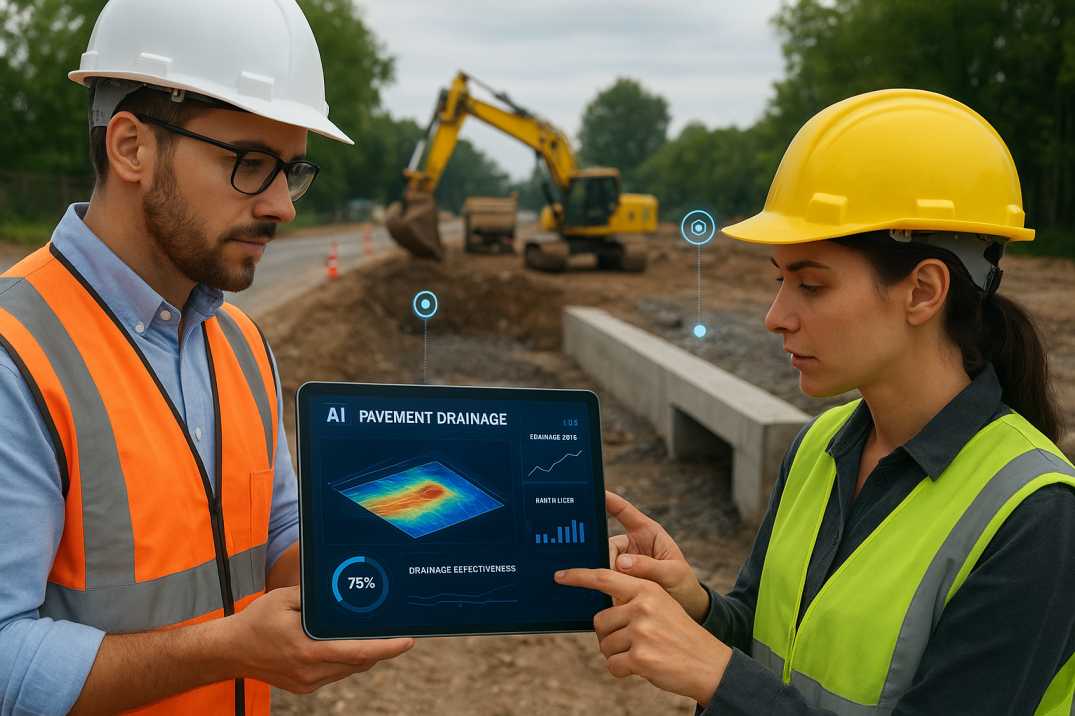Contact Us
RoadVision AI
Private Limited
Office No. 308 & 310, B Block
Ansal Chamber - 1, Bhikaji Cama Place,
Near Engineers India Limited (EIL) Bhawan, New Delhi - 110066
© 2024 | RoadVision AI | All rights reserved
The efficiency of any modern roadway depends on two key factors—effective pavement drainage and intelligent asset management. Poor drainage can lead to rutting, pumping, and early pavement deterioration, increasing maintenance costs and reducing safety. Today, the integration of AI-powered road asset management with geosynthetics for pavement drainage has transformed how road networks are built and maintained, ensuring longer pavement life, reduced repair costs, and sustainable infrastructure growth.

Geosynthetics in road construction are synthetic materials such as geotextiles, geogrids, and geocomposites used to enhance soil behavior, control drainage, and provide reinforcement. In drainage applications, these materials:
According to IRC guidelines such as IRC:SP:59 and IRC:37-2023, properly designed geosynthetic drainage layers can extend pavement life by preventing water accumulation and subgrade weakening. By combining these with AI-based road inspections, agencies can identify where drainage inefficiencies are occurring in real time.
When water seeps into pavement layers without adequate outlets, it causes the subgrade to lose stiffness. Under traffic loads, this leads to rutting (permanent surface deformation) and pumping (ejection of fine materials mixed with water through cracks and joints).
By using pavement drainage solutions integrated with digital road monitoring systems, engineers can ensure consistent removal of infiltrated water, protecting the structural integrity of the road base and surface.
The integration of AI in asset management allows authorities to move from reactive to predictive maintenance. Platforms like RoadVision AI use advanced analytics and machine learning to assess every layer of the pavement—surface, subsurface, and drainage.
With tools such as AI road survey tools and AI-based road inspections, engineers can:
This predictive approach reduces downtime, lowers maintenance costs, and enhances the performance of geosynthetics for pavement drainage across the entire network.
Using geosynthetics in road construction is a proven method for improving pavement performance under varying traffic and environmental conditions. Key benefits include:
These functions prevent premature pavement damage and enable resilient infrastructure. When combined with continuous insights from AI-powered road asset management systems, agencies can optimize their maintenance strategies using accurate, data-backed evidence.
Modern infrastructure management depends on continuous feedback from digital road monitoring systems. These systems use IoT and AI to collect real-time pavement data, such as subsurface moisture, structural performance, and temperature impact.
Such monitoring ensures that pavement drainage solutions remain effective and adaptable throughout the pavement life cycle.
Combined with traffic survey analytics, authorities can correlate drainage performance with traffic loading patterns—helping identify problem zones before damage spreads.
AI road survey tools play a key role in evaluating how geosynthetics and drainage systems are performing in live conditions. High-resolution video analytics and deep learning algorithms enable precise detection of:
This data-driven insight allows engineers to modify designs and maintenance schedules proactively, resulting in more sustainable road networks.
Combining geosynthetics for pavement drainage with AI-powered road asset management represents a revolutionary step toward smarter, more sustainable infrastructure. The synergy between material innovation and AI analytics ensures reduced rutting, minimized pumping, and prolonged pavement service life.
RoadVision AI is revolutionizing the way we build and maintain infrastructure by leveraging the power of AI in roads to enhance road safety and optimize road management. By utilizing cutting-edge roads AI technology, the platform enables the early detection of potholes, cracks, and other road surface issues, ensuring timely maintenance and improved road conditions. With a mission to create smarter, safer, and more sustainable roads, RoadVision AI ensures full compliance with IRC Codes, empowering engineers and stakeholders to make data-driven decisions that reduce costs, minimize risks, and improve the overall transportation experience.
To experience how intelligent pavement management can transform your infrastructure operations, book a demo with us today.
1. What are geosynthetics and how do they help in pavement drainage?
Geosynthetics are synthetic materials used to enhance drainage, separation, and reinforcement in pavements, preventing rutting and subgrade failure.
2. How does AI improve pavement drainage monitoring?
AI-driven systems like RoadVision AI analyze real-time data to detect drainage inefficiencies and predict pavement distress before major damage occurs.
3. Why combine AI with geosynthetics in road construction?
This combination ensures both physical and digital resilience — geosynthetics manage water effectively, while AI ensures long-term monitoring and optimization.